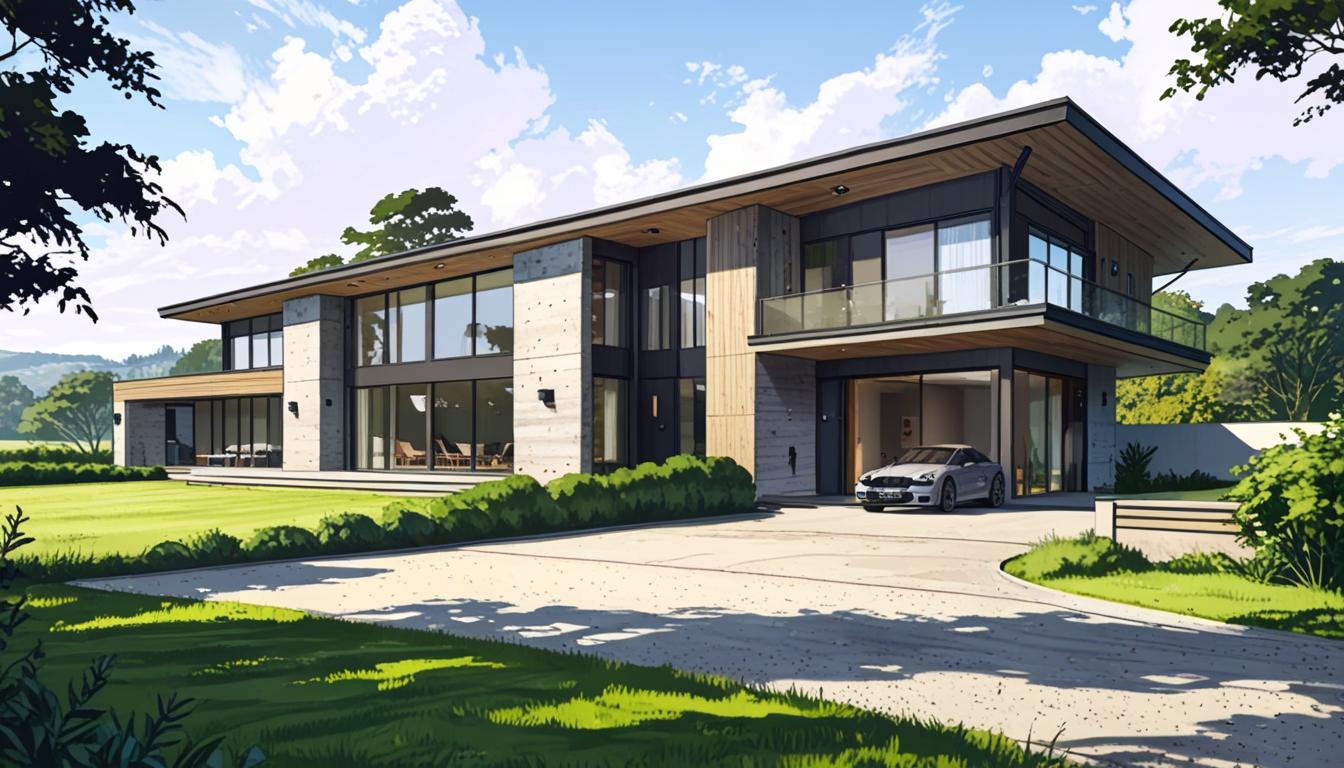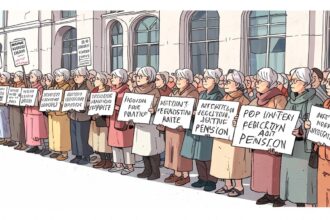Gloucestershire’s countryside is witnessing a surge of striking, contemporary homes built under Paragraph 84 of the National Planning Policy Framework, also known as the ‘Grand Designs’ clause, enabling outstanding architectural projects in protected natural areas despite local opposition.
A less well-known planning regulation, often referred to as the ‘Grand Designs’ clause, is enabling wealthy individuals to construct strikingly modern and high-specification homes in the Gloucestershire countryside, including within protected Areas of Outstanding Natural Beauty (AONB). This legal provision, Paragraph 84 of the National Planning Policy Framework (NPPF), allows for exceptional architectural projects to be approved in rural areas if they meet stringent criteria of “exceptional quality” and set new design standards.
Gloucestershire has become a focal point for such innovative builds, with projects like Headlands near Prestbury, Cheltenham, and Swinhay House near Wotton-under-Edge standing as prime examples. Headlands, finished in 2018, is notable for its unique leaf-shaped zinc roof and cutting-edge interiors. It has been acclaimed as one of the UK’s most extraordinary architectural achievements, fulfilling the demanding quality benchmarks required by Paragraph 84.
Similarly, Swinhay House, which featured in the final episode of the BBC’s Sherlock series three, exemplifies the audacious and contemporary designs achievable under this policy. Its curved structure and large observatory tower provided an iconic setting for portraying the character Charles Augustus Magnussen. The house garnered widespread media attention due to its distinctive and visionary architecture.
Richard Hawkes, founder and director of Hawkes Architecture, a firm renowned for specialising in Paragraph 84 homes, has overseen 36 such projects—more than any other practice in the country. He highlighted the evolution of the policy, explaining to the Birmingham Mail, “The policy is 28 years old. It was all about continuing the tradition of the English country house, because it’s quintessentially English to have these types of home. But in the early noughties it shifted to a more contemporary interpretation of this rather than the classic country estate. Since then, the wording has changed several times and they are now called ‘Paragraph 84’ homes.”
Hawkes further remarked on the synergy between the policy and popular media: “Grand Designs has become a bit of a flag bearer for the policy – it’s almost a symbiotic relationship with the programme.” He also expressed pride that all 16 Paragraph 84 homes designed by his firm remain occupied by their original owners, emphasising the enduring appeal of these homes.
Paragraph 84 (e) of the NPPF mandates that homes built under this provision must be “truly outstanding, reflecting the highest standards in architecture” and should enhance their surroundings without detracting from the local vernacular. The planning process is rigorous and costly, often exceeding £100,000 just in planning stages, with total costs reaching into the millions based on the complexity and scale of the build.
“They shouldn’t need to hide – or apologise for being there – because they are outstanding and exceptional,” Hawkes said about such properties, adding that selecting the right site is a complex challenge requiring extensive surveys and reports.
Other notable examples of Paragraph 84 homes include Bigbury Hollow in Kent, near the Iron Age hill fort of Bigbury Camp. This build features large terraced courtyards surrounded by subterranean wings, blending sunlit spaces with the natural landscape. Costing around £1.5 million, it was featured on the 23rd series of Grand Designs in an episode titled “Canterbury 2022.” Host Kevin McCloud described the house as “like a concrete submarine which has breached the surface of a wildflower meadow and come up for air.”
Another innovative project is the Lake House within East Sussex’s High Weald National Landscape. Situated on 40 acres beside a former fishing lake and an abandoned railway line, this property’s design pays homage to its railway heritage with three separate “carriages” nestled among the trees.
Rob Hughes, director of Hughes Planning—a firm collaborating with Hawkes Architecture on Paragraph 84 projects—emphasised the specialised nature of these developments. He explained, “Not every site will be able to accommodate a Para 84 home so it’s important that people seek out professional advice, someone with the right expertise, as it really is a niche.” Hughes described the multidisciplinary teams required for these projects, which include planning consultants, architects, ecologists, arboriculturalists, flood and drainage experts, engineers, and sustainability specialists.
Hughes also dispelled assumptions that such homes are exclusively for billionaires. “It’s not something you can do half-heartedly, you have to have a lot of money to do it, but equally it’s not billionaire territory – it’s really a mix of clients we get.”
He outlined common reasons why some Paragraph 84 proposals fail to obtain approval: “First, it does not significantly enhance the area, second, it is not within the defining characteristics of the area, and finally it’s simply not outstanding enough.”
Despite the high calibre of these developments, there is occasionally pushback from local communities. Richard Hawkes commented, “We get some communities who are very supportive and the parish councils saying it’s forward-thinking, but more often than not there is nimbyism to the proposals.” Rob Hughes added, “Some members of the public don’t like the idea but really there’s a requirement for the homes to be isolated so it’s not really going to affect them.”
The Birmingham Mail is reporting that these exceptional builds continue to attract affluent buyers eager to commission unique, sustainable, and architecturally significant rural homes under the Paragraph 84 planning exemption, reshaping perceptions of what countryside residences can be in the 21st century.
Source: Noah Wire Services
- https://assets.publishing.service.gov.uk/media/67aafe8f3b41f783cca46251/NPPF_December_2024.pdf – This document provides the framework for planning policies in England, including the criteria for housing development. It supports the claim that Paragraph 84 allows for exceptional architectural projects in rural areas.
- https://www.austindw.co.uk/modern-country-house-design-paragraph-84-architect-in-gloucestershire – This article highlights the expertise of architects in achieving permissions for Paragraph 84 homes, illustrating how Gloucestershire is a hub for such modern country house designs.
- https://www.hughesplanning.co.uk/explained – This site explains Paragraph 84 of the NPPF and how it enables new country houses to be built with exceptional quality of design, often in protected areas like Green Belts and National Landscapes.
- https://www.gov.uk/government/publications/national-planning-policy-framework–2 – This publication outlines the revised National Planning Policy Framework, which sets out policies for England, including those related to rural development under Paragraph 84.
- https://www.gov.uk/guidance/national-planning-policy-framework – This guidance provides further details on the National Planning Policy Framework, explaining how policies are applied, including those affecting rural development.
- https://www.birminghammail.co.uk/news/midlands-news/controversial-rural-homes-built-under-24611157 – This article from the Birmingham Mail discusses the evolution of the Paragraph 84 policy and its impact on rural development, including the challenges and controversies surrounding these projects.
- https://www.birminghammail.co.uk/news/uk-news/grand-designs-clause-helping-super-31499490 – Please view link – unable to able to access data
Noah Fact Check Pro
The draft above was created using the information available at the time the story first
emerged. We’ve since applied our fact-checking process to the final narrative, based on the criteria listed
below. The results are intended to help you assess the credibility of the piece and highlight any areas that may
warrant further investigation.
Freshness check
Score:
7
Notes:
Narrative references specific projects from 2018 and 2022, and discusses a 28-year-old policy updated through the 2000s. While not breaking news, it contextualises recent applications of Paragraph 84.
Quotes check
Score:
8
Notes:
Direct quotes from Richard Hawkes and Rob Hughes appear original and specific to the Birmingham Mail’s reporting. No earlier attribution found for these statements.
Source reliability
Score:
8
Notes:
Birmingham Mail is a regional UK newspaper with established editorial standards. Expertise demonstrated through detailed policy analysis and named professional sources.
Plausability check
Score:
9
Notes:
Claims align with verifiable planning regulations (Paragraph 84 NPPF) and named architectural projects. Specialists’ comments reinforce feasibility, though niche nature limits broad verification.
Overall assessment
Verdict (FAIL, OPEN, PASS): PASS
Confidence (LOW, MEDIUM, HIGH): HIGH
Summary:
Narrative provides credible, detailed insight into Paragraph 84 homes, supported by expert commentary and verifiable project examples. Original quotes and regional reporting lend authenticity.













